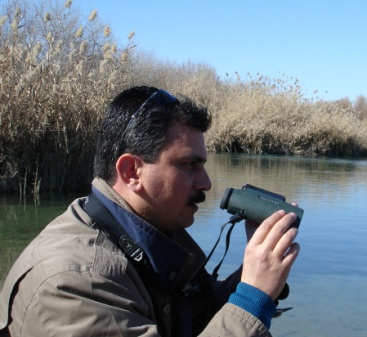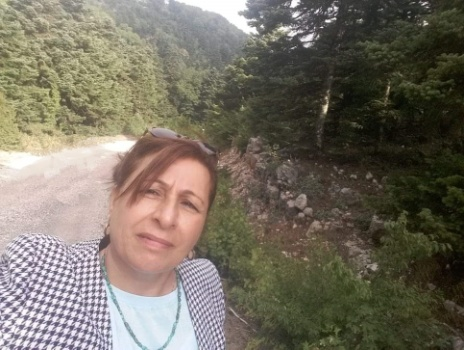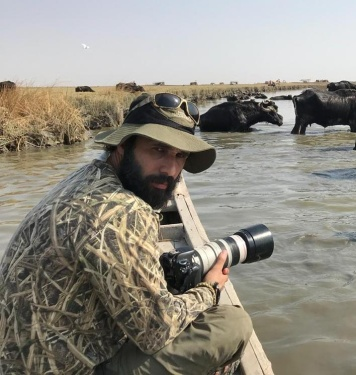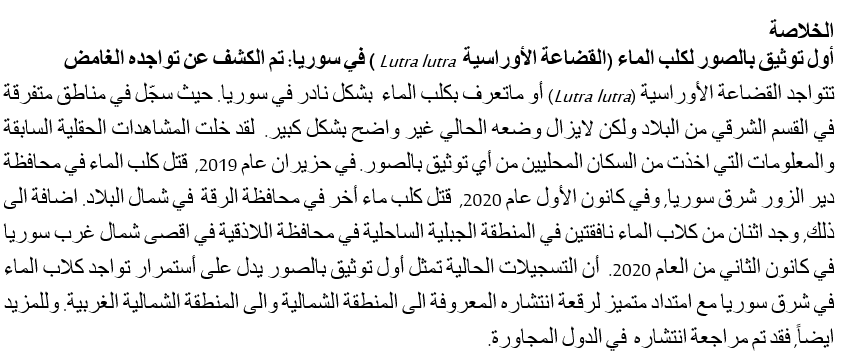IUCN/SSC Otter Specialist Group Bulletin

©IUCN/SCC Otter Specialist Group
Volume 38 Issue 5 (December 2021)
Citation: Aidek, A., Baddour, F.S. , Ibrahim, N.N. and Al-Sheikhly, O.F. (2021). The First Photographic Records of the Eurasian Otter Lutra lutra in Syria: Its Mysterious Occurrence is Revealed. IUCN Otter Spec. Group Bull. 38 (5): 258 - 266
The First Photographic Records of the Eurasian Otter Lutra lutra in Syria: Its Mysterious Occurrence is Revealed.
Ahmad Aidek1, Firas S. Baddour2, Nahla N. Ibrahim3, and Omar F. Al-Sheikhly4*
1Directorate of Biodiversity, Ministry of Local Administration and Environment, Syria. ah_aidek@hotmail.com
2Directorate of Agriculture, Latakia, Syria. faresbader2@gmail.com
2College of Science-Tishreen University, Latakia, Syria. D.alya-n@hotmail.com
4Department of Biology, University of Baghdad, Iraq. alsheikhlyomar@gmail.com
*Corresponding Author
(Received 18th February 2021, accepted 6th June 2021)
Abstract: The Eurasian Otter (Lutra lutra) has been recorded only rarely in Syria. Known only from few scattered localities in the eastern part of the country, but its current status is extremely unclear. Previous field observations and local communities’ information lack photographic documentation. In June 2019 and December 2020, two Eurasian otters were killed in the Lower Syrian Euphrates valley; single Eurasian Otter was killed in Deir ez-Zor and another in Ar Raqqah provinces in eastern and northern Syria, respectively. Moreover, in January 2020, two dead Eurasian otters were found in the mountainous costal region in Latakia Province in extreme northwestern Syria. These current records represent the first photographic documentation for the persistence of the Eurasian Otter in eastern Syria, and remarkable extensions of known range in the northern and northwestern regions. Furthermore, the species distribution range in the neighboring countries was also reviewed.
Keywords: Eastern Syrian plateau; Euphrates River; Eurasian Otter; Hunting and trapping; Mediterranean coast.
THE STATUS OF EURASIAN OTTER IN SYRIA
Syria (32° to 37° N and 35° to 42°E) lies at the eastern side of the Mediterranean Sea with a coastline of a183km. It has two mountain chains parallel to the coastline; a rift between the chains is an extension of the Red Sea. Besides elevated grounds, dry steppes, arid lands and semi-deserts are the main habitats of the Syrian plateau which occupies the majority (ca. 55%) of the country’s area with elevation of about 500m a. s. l.. The Euphrates, Tigris, and Orontes are the major rivers crossing Syria (Barkoudah et al. 2002; Aidek 2010) (Fig. 1).
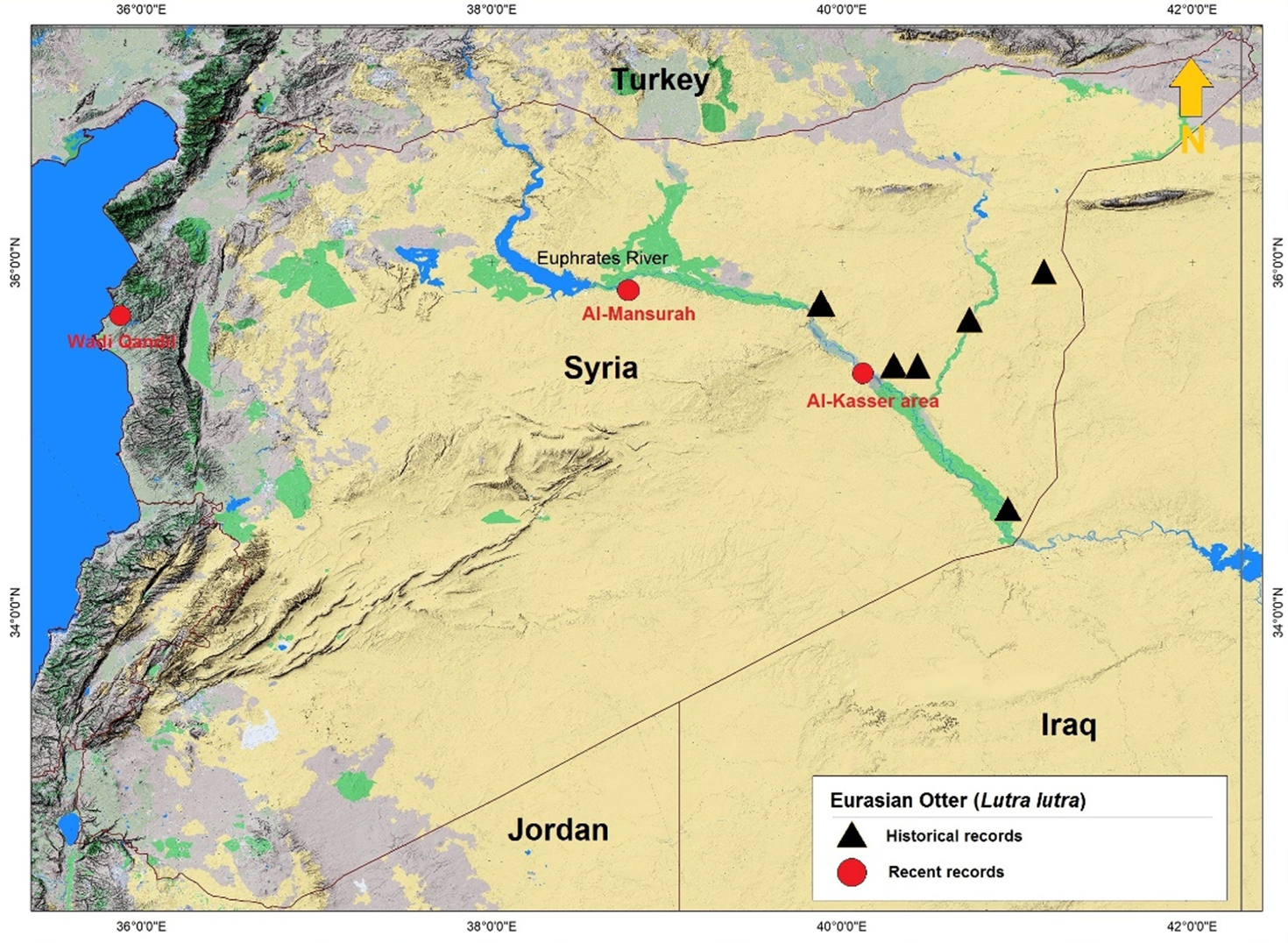
The Eurasian otter (Lutra lutra) is one of the most widespread otter species, inhabiting a variety of habitats in Western Europe, across most of the Palearctic, down to India, Southeast Asia, North Africa, and the Middle East (Roos et al., 2015; Duplaix and Savage, 2018; Yoxon and Yoxon, 2019; Al-Sheikhly et al., 2020).
The current status of the Eurasian Otter in Syria is not well known, but it seems to be extremely rare. Naderi et al. (2017) indicated that the species is endangered across the Middle East and Turkey; rare and isolated in Syria and Jordan and becoming rare in Iraq. Most literature records are of sporadic field observations and anecdotal interviews with local communities. Foster-Turley and Santiapilliai (1990) and Conroy et al. (1998) indicated that the Eurasian otter occurs in rivers of the neighboring countries and is therefore probably present in Syria; but no recent information was available to them. Data collected between 1989 and 1998 appear to indicate that a considerable population of Eurasian otters is still present in the Lower Syrian Euphrates valley in northeastern and eastern Syria, an area comprising the Euphrates River, its tributary the Khabur River and the border with Iraq (Masseti, 2009; Al-Sheikhly et al., 2020). Records from Doura Europos and Deir ez (el)-Zor in eastern Syria were presented by Jacques (1998) who indicated that the species’ population has declined over the last 40 years mainly due to hydrological schemes at Deir-ez-Zor during and following the construction of the Tabaqa Dam (Lake Assad). Later on, the occurrence of the Eurasian Otter was reported from an island in the Euphrates at Doura Europos, Halabiyyeh, and from Tell Sheikh Hamad, along the Khabur River, all sites in the district of Deir-ez-Zor (Kock et al., 1994; Uhrin et al., 2000). Shihab (2002) referred to the possible occurrence of the Eurasian otter in the Al-Yarmouk valley, Al-Asi River, Euphrates River, and around major lakes and dams of Tigris River in northeastern Syria. Two stuffed specimens (one adult and one sub-adult) had been captured at Basamfasal, a suburb of Deir ez-Zor along the Euphrates River up to the north of Abu Kamal (at the Iraqi border; see Masseti 2001, 2004). However, the easternmost claimed records seem doubtful as the habitat of that region is primarily semi-deserts. The species is reported from Al Mayaddin and Doura Europos, but it was absent in the northwestern area of Raqqa “Ar Raqqah” (Masseti, 2009). Furthermore, Murdoch and Aidek (2012) mentioned that few Eurasian otters are still present along the Lower Syrian Euphrates, but presented no physical evidence confirming their occurrence. Moreover, Daoud and Khalil (2018) indicated that the Eurasian Otter seems to be confined along the Euphrates River in eastern Syria to only few localities: no records were generated during recent surveys (Fig. 1).
The status of the Eurasian Otter in the neighboring countries is also not fully unknown. In Turkey, the Eurasian Otter population has been notably reduced over the past 50 years (see Eroglu, 1994); however, it has been recorded throughout west and east of the country, and around the Black Sea (MacDonald and Mason, 1994; Toyran and Albayrak, 2019). A recent increase in the northeastern population was attributed to the development of aquaculture (Conroy et al., 1998). In Iraq, the species occurs in almost all suitable aquatic habitats along the Tigris and Euphrates Rivers, mainly in the southern parts of the country (Mesopotamian marshes), although few records are known from central and the north (Kurdistan) (Harrison and Bates, 1991; Al-Sheikhly and Nader, 2013). Recently, a remarkable range extension was noted in extreme northwestern Iraq close to the eastern Syrian border (Al-Sheikhly et al., 2020). In Jordan, the species is restricted to the River Yarmouk and River Zarka and is still thriving in the River Jordan, yet its population size is not well known (MacDonald and Mason, 1994; Reuther et al., 2001; Yoxon and Yoxon, 2019). In Lebanon, the Eurasian Otter was recorded at Ammik Swamp, suspected in the western Bekaa valley and in the River Litani, and recorded from Hima Anjar (Hima Kfar Zabad, Anjar, Beqaa Valley) (Lewis et al., 1968; Harrison and Bates, 1991; Masseti, 2009; Loy et al., 2016; Ramadan-Jaradi et al., 2019). The Eurasian Otter was recorded from the shores of Lake Tiberias, Lake Huleh, the Sea of Galilee, the Lower reaches of the Jordan River, Dan, the Beteha Valley, Tirat Zevi, Bet She’an Valley, near Akko on the northern coastal plain and in the borders with Lebanon (MacDonald et al., 1986; Yom-Tov, 1986; Harrison and Bates, 1991; Dolev et al., 2006). However, the Eurasian otter population has dramatically declined since 1960s, and fewer than 100 individuals might remain (see Yom-Tov, 1986; Shalmon, 1994; Reuther and Dolev, 2000; Dolev and Perevolotsky, 2004). The species has disappeared from the southern coastal plain and it is now restricted to En Nimfit Nature Reserve in the northern coastal plain, with a resident population in the Golan Heights (Illani, 1987; 1988). A single record from the Zvulun Valley and Carmel coastal area suggests the existence of a remnant population along the coast, which might be now extinct (Dolev et al., 2006; Guter et al., 2006).
RECENT RECORDS IN SYRIA
The persistence of the Eurasian Otter at two localities in the Lower Syrian Euphrates valley of the eastern desert plateau in Deir ez-Zor Province with additional new localities in the northern and northwestern Syria in Ar Raqqah and Latakia provinces is reported here. These records are based on photographs of dead specimens supplied by fishermen and supported by information from local communities in Deir ez-Zor and Ar Raqqah provinces, and by recent field surveys conducted in the coastal region in Latakia Province (Fig. 1).
An adult Eurasian Otter (sex unknown) was photographed by a local fisherman along the western bank of the Euphrates River in the Al-Kasser area (35°21'N 40°07'E), facing a river island called Hawaeijt Kate’e, to the north of the main city of Deir ez-Zor Province in June 2019 (Fig. 2A). As has happened in the Upper Euphrates River Basin inside Iraq (see Al-Sheikhly et al., 2020), that Eurasian otters had reportedly drowned in a drift net set by local fishermen, here in the main watercourse of the Euphrates River. An adult Eurasian Otter (sex unknown) was deliberately killed by local fisherman using a hunting rifle (12mm calibre) on the western bank of the Euphrates River in Al-Mansurah (35°51'N 38°44'E), ca. 16 km south of Tabaqa Dam (ca. 140 km to the northwest of the Al-Kasser area) in Ar Raqqah Province in December 2020 (Fig. 2B).
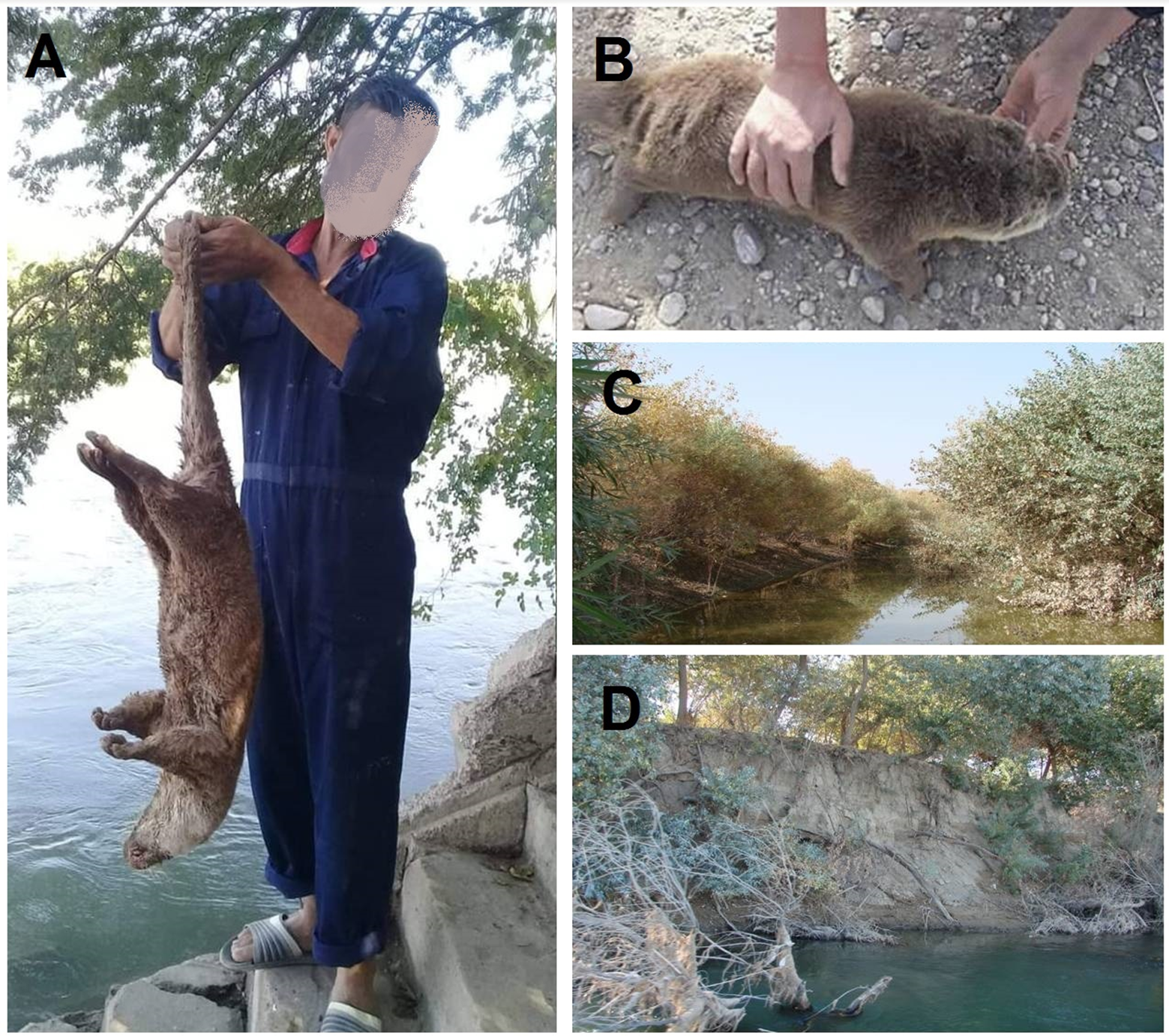
Both sites are situated within the Middle East Steppe Ecoregion (see Olson et al., 2001) and the general habitats are mixture of cultivated annual crops and vegetable farms irrigated by well-vegetated canals and water management schemes flanking the steep muddy banks of the Euphrates River. One of the most important habitats of the Lower Syrian Euphrates valley is provided by the many islands fringed by Common Reed Phragmites australis and Common Bulrush Typha latifolia that have formed as a result of the Euphrates River’s declining flow; these islands are known locally as “hawaeij”. The vegetation is comprised mainly of riparian species mainly Tamarisk Tamarix shrubs, Euphrates Poplar Populus euphratica, Willow Salix trees, and scattered Date palm Phoenix sp. orchards (Fig. 2C & D).
Recent field surveys in the coastal region of the Mediterranean Sea in northwestern Syria recorded two Eurasian otters. An adult female was found dead by Firas Baddour on the eastern bank of a narrow mountainous stream of the Wadi Qandil plain to the south of the village of Wadi Qandil (35°42'N 35°52'E), ca. 3.5 km from the seashore in Latakia Province on 27 January 2020 (Fig. 3A & B). Interviews with local villagers indicated that another otter (unknown sex) was found dead, decomposed, and buried by the villagers at the same place later on. The dead otters did not show any signs of physical injuries such as hunting wounds. The villagers indicated that pesticides (mainly insecticides) are widely used in the adjacent farms. These might have contributed to both otters’ deaths. Moreover, the villagers also indicated that they believe otters raid their poultry and livestock, so are vulnerable to poisonous baits set for stray dogs.
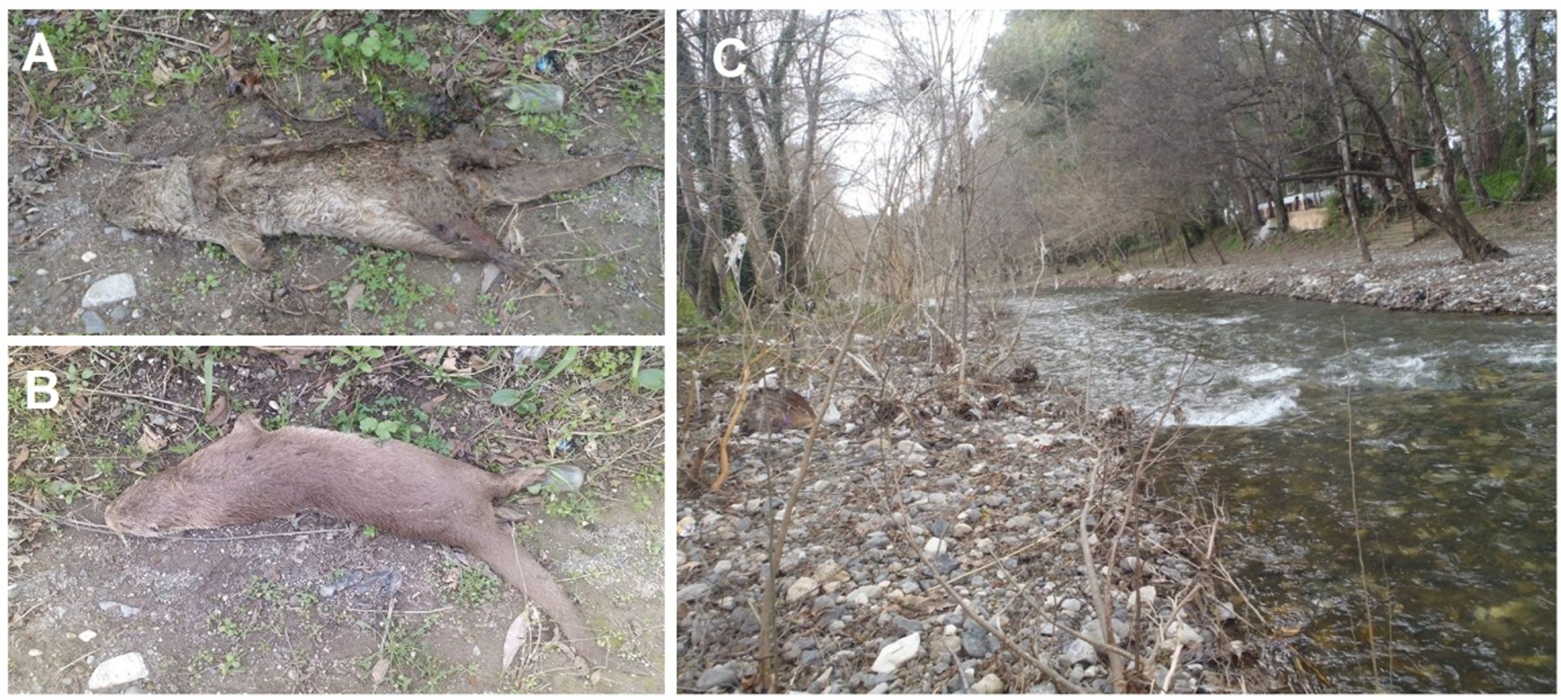
The general landscape of the site resembles the Eastern Mediterranean Forest Ecregion (Olson et al., 2001) of the mountain forests and wooded valleys infiltrated by narrow freshwater streams, creeks, and springs which extending along the northwestern Syrian coast. Cultivated fields of citrus fruit and vegetable farms, Pine Pinus sp., Olive Olea europaea, Oriental Alder Alnus orientalis, and Oriental Plane Platanus orientalis trees lined with hedges are extending along the meadows of Wadi Qandil plain (Fig. 3C).
CONCLUSIONS
Based on the very few historical records, dated from 1989–1998 (see Masseti, 2009), the current status of Eurasian Otter in the Lower Syrian Euphrates valley in eastern Syrian plateau remains enigmatic. Jacques (1998) suggested that if Eurasian Otter was present in the Euphrates River in eastern Syria, then it might have come from up- or downstream reaches, in bordering countries. Furthermore, Masseti (2009) reported that a small population of the Eurasian otters is still present in eastern Syria between the confluence of the Euphrates with the Khabur River and the border with Iraq. Al-Sheikhly et al. (2020) reported the occurrence of the Eurasian Otter in the Euphrates River in the vicinities of Anah and Rawa on extreme northwestern Iraq close to the Syrian borders. Al-Sheikhly et al. (2020) also mentioned that two distinct isolated populations of the Eurasian Otter might be present in the Upper Euphrates River Basin across the area of western Iraq and eastern Syria where the species appears to be rare. Based on the above, the current records represent the first photographic documentation for the species’ persistence in eastern Syria, and a remarkable extension of known range to the north.
The finding of the Eurasian otter in the coastal region is significant; the occurrence of the species in the northwestern Syria has never been reported. The specimens of Wadi Qandil plain represent the first documented record of the occurrence of the Eurasian Otter in the coastal region of the Mediterranean Sea in northwestern Syria. This suggests that a small isolated population may inhabit northwestern Syria, possibly originating from the Anatolian population in southern Turkey (see Thol-Schmitz, 2004) but this requires further investigation. In spite of the increase of the knowledge on the species’ distribution in recent years, however, the current records suggest the possible occurrence of at least two (eastern and northern) distinct subpopulations and mark out a significant expansion of the species’ known range in northwestern Syria.
The Eurasian Otter is occupying a large geographic range where its global population is increasing in some parts, and in much of it broadly stable. However, in other parts, the species facing a dramatic decline due to man-made impacts on aquatic ecosystems, the lack of information from many regions of its range, and the sensitivity of the species to sudden changes in threats; therefore, it has been listed as Near Threatened by the IUCN Red List (Roos et al., 2015). In the Middle East, the Eurasian Otter populations are highly endangered due to illegal killing, dam construction, water shortages and pollution, marshland drainage, and lack of legal protection or law enforcement (Duplaix and Savage, 2018). The species is endangered and declining in Turkey and rare and isolated in Syria, Jordan, and is becoming extremely rare in Iraq (Naderi et al. 2017; Al-Sheikhly et al. 2020). A total of 30,000 otters are killed in Turkey annually and the species is targeted where/whenever possible in Iraq due to conflict with fishermen and for the fur trade (Smit and van Wijngaarden, 1976; Conroy et al., 1998; Al-Sheikhly and Nader, 2013; Al-Sheikhly et al., 2014). Moreover, strangulation and drowning in drift nets and other fishing nets has been highlighted as a major cause of mortality of Eurasian otters across multiple countries (Reuther and Hilton-Taylor, 2004; Roos et al., 2015). In Syria, Eurasian otters seem to be threatened by direct persecution which is evident by our recent observations; however, further information is needed to be sure. Aidek (2010) indicated that illegal hunting (using of electrocution, dynamite, and poisoning) and pollution are the major threats to the wildlife of the Lower Syrian Euphrates. In western and central Europe, pollutants such as the organochlorines dieldrin and DDT/DDE, polychlorinated biphenyls (PCB), and the heavy metal mercury, were harmful to otters (Roos et al. 2012). In regard to the Eurasian otter’s vulnerability to climate change, consistent losses are predicted for the species’ southern portion of range, especially in Central Asia, eastern Himalaya, China, South East Asia, North Africa, and the Middle East (Duplaix and Savage, 2018). In sum, urgent conservation actions are warranted for Eurasian otter populations throughout the Middle East and Iraq (Al-Sheikhly et al., 2014). Nowadays, reflecting current unrest and very poor coverage by researchers, data on the mammalian fauna in the Lower Syrian Euphrates valley are scarce and rarely available (Murdoch and Aidek, 2012). However, further field surveys and in situ monitoring is required to reveal the full status and, notably, the main threats of this species in Syria, especially in southern regions that adjacent to Jordan and Lebanon where a small population may still present.
Acknowledgements: We are grateful to the Tishreen University, Latakia, Syria, and the Higher Commission for Scientific Research, Damascus, Syria for their logistic support to our study on the protected areas, lost habitats, and threatened vertebrates in the Syrian coastal region in Latakia Province. We would like to thank Dr. Amir Ibrahim (head of the research team, Higher Institute of Marine Research- Tishreen University) for his support; to Sa’ad Attobi and Hassan Al-Mustafa for providing photographs of the dead otters in Deir-ez-Zor and Ar Raqqah provinces and their kind permission to be published in this report. We would also thank the anonymous reviewers for their thoughtful comments on the initial draft of this report.
REFERENCES
Aidek, A.E. (2010). A guide to the Biodiversity of Deir ez-Zor Area. Al-Qudis House for Sciences, Damascus, Syria. 112pp. [In Arabic]
Al-Sheikhly, O.F., Haba, M.K., Barbanera, F. (2014). Otter hunting and trapping, a traditional practice of Marsh Arabs of Iraq. IUCN Otter Specialist Group Bulletin 31(2): 80–88.
Al-Sheikhly, O.F., Haba, M.K., Fazaa, N.A., Barbanera, F., Yoxon, G., Mclennan, B., Zook, D.B., Al-Kanani, K.A., Abdul Gafor, S.A. (2017). First photographic evidence of Smooth-coated otter (Lutrogale perspicillata maxwelli) and Eurasian otter (Lutra lutra seistanica) in Iraq since 1950s. OTTER, Journal of the International Otter Survival Fund 3: 15–20.
Al-Sheikhly, O.F., Nader, I.A. (2013). The status of Iraq smooth-coated otter Lutrogale perspicillata maxwelli Hayman 1956 and Eurasian otter Lutra lutra Linnaeus 1758 in Iraq. IUCN Otter Specialist Group Bulletin 30: 18–30.
Al-Sheikhly, OF, Haba, MK, and Barbanera, F (2020). New Localities of the Eurasian Otter Lutra lutra (Linnaeus, 1758) in the Upper Euphrates River Basin, a Remarkable Range Extension in Western Iraq. IUCN Otter Spec. Group Bull. 37 (3): 163–170.
Barkoudah, Y., Darwish, A. I. & Antoun, M. A. (2002). Biological Diversity National Report, Biodiversity Strategy and Action Plan and Report to the Conference of the Parties NBSAP Project SY/97/G3. Ministry of Environment- Tolyani- Damascus-Syria. 34pp.
Conroy, J, Melisch, R and Chanin, P (1998) The Distribution and Status of the Eurasian Otter (Lutra lutra) in Asia - a Preliminary Review. IUCN Otter Spec. Group Bull. 15(1): 15 - 30
Daoud, A., Khalil, N. (2018). Status and distribution of the carnivores of the Mustelidae and Herpestidae in Syria. Journal of Damascus University for Basic Sciences 34(2): 69–94.
Dolev, A., Guter, A., Saltz, D., Kronfeld-Schor, N. (2006). Israel’s otter (Lutra lutra) population, status and future conservation. In: Conroy, J.W.H., Yoxon, G., Gutleb, A.C., Ruiz-Olmo, J. (eds.). The return of the Otter in Europe—where and how? 2003 June 30– July 5. Sabhal Mor Ostaig Isle of Skye Broadford: OTTER, International Otter Survival Fund. p. 1–7.
Dolev, A., Perevolotsky, A. (eds.) (2004). The red book of vertebrates in Israel. Jerusalem (Israel): Israel Nature and National Parks Protection Authority and Society for Protection of Nature in Israel Press.
Duplaix, N. & Savage, M. (2018). The Global Otter Conservation Strategy. IUCN/SSC Otter Specialist Group, Salem, Oregon, USA. 186pp.
Eroglu, M. (1994). The status and habitat destruction of the otter (Lutra lutra) in the eastern Black Sea region of Turkey. In: Seminar on the Conservation of European otter (Lutra lutra), Leeuwarden, the Netherlands, 7–11 June 1994. pp. 81–83. Council of Europe, Strasburg.
Foster-Turley, P. & Santiapillai, C. (1990). Action Plan for Asian Otter. In: Foster-Turley, P., Macdonald, S.M., Mason, C.F. (eds). Otters - an Action Plan for their Conservation. IUCN, Gland, Switzerland. 62 pp.
Guter, A., Dolev, A., Saltz, D., Kronfeld-Schor, N. (2006). Do otters occasionally visit Israel’s coastal plain? IUCN Otter Specialist Group Bulletin 23(1): 12–14.
Harrison, D.L., Bates, P.J.J. (1991). The Mammals of Arabia. Harrison Zoological Museum, Sevenoaks, Kent, U.K.
Illani, G. (1987). The last otters on the coastal plain. Israel Ld Nat. 12(4):170.
Illani, G. (1988). Otters still live on the Golan Heights. Israel Ld Nat. 14(1): 245.
Jacques, H. (1998). Eurasian otter (Lutra lutra) still present in Syria. IUCN Otter Specialist Group Bulletin 15(2): 112–113.
Kock, D., Krupp, F., Schneider, W. (1994). Einige Säugetiere aus dem Nahr al-Khabur-Gebiet, NE-Syrien. Säugetierkundliche Mitteilungen, 35 (4): 177–183. [In German]
Lewis, R.E., Lewis, J.H., Atallah, S.I. (1968). A review of Lebanese mammals. Carnivore, Pinnipedia, Hyracoidea and Artiodactyla. Journal of Zoology 154: 517–531.
Loy, A., Al-Jawhary, D., Berj, T., Giuseppina, D., Lerone, L. (2016). An action plan for the Eurasian Otter in the Hima Kfar Zabad (Anjar, Beqaa Valley, Lebanon). XIII International Otter Congress, Singapore.
MacDonald, S.M., Mason, C.F. (1994). Status and conservation need of the otter (Lutra lutra) in the western Palaearctic. Council of Europe, Strasbourg.
MacDonald, S.M., Mason, C.F., Shalmon, B. (1986). A survey for otters in Israel. Oryx, 20: 233–236.
Masseti M (2001). A lost collection of bird and mammals from Northern Syria (1989–1994). 13th International Conference of the Society for the History of Natural History “Lost, stolen and strayed. The fate of missing natural history collections”. 10–11 Maggio 2001. Naturalis, The National Museum of Natural History, Leiden (Olanda). Abstract book: 22.
Masseti M (2004). Artiodactyls of Syria. Zoology in the Middle East 33: 139–148.
Masseti, M. (2009). Carnivores of Syria. ZooKeys 31: 229–252.
Murdoch, D.A. & Aidek A. (2012). Birding Sites of the OSME Region 8-The birds of the lower Syrian Euphrates. Sandgrouse 34: 152–176.
Naderi, S., Mirzahani, A., Hadipour, E. (2017). Distribution of and Threats to the Eurasian otter (Lutra lutra) in the Anzali Wetland, Iran. IUCN Otter Specialist Group Bulletin 34(2): 84–94.
Olson, D. M., Dinerstein, E., Wikramanayake, E. D., Burgess, N. D., Powell, G. V. N., Underwood, E. C., D'Amico, J. A., Itoua, I., Strand, H. E., Morrison, J. C., Loucks, C. J., Allnutt, T. F., Ricketts, T. H., Kura, Y., Lamoreux, J. F., Wettengel, W. W., Hedao, P., Kassem, K. R. (2001). Terrestrial ecoregions of the world: a new map of life on Earth. Bioscience 51(11):933–938.
Ramadan-Jaradi, G., Serhal, A., Khatib, B. (2019). Towards a cooperation between the Eurasian otter (Lutra lutra) and local people of Hima Anjar/Kfarzabad, Lebanon. A case study. OTTER, Journal of the International Otter Survival Fund 5: 26–29.
Reuther, C., Dolev, A. (2000). New findings of otters (Lutra lutra) in Israel. IUCN Otter Specialist Group Bulletin 17(2): 80–82.
Reuther, C., Hilton-Taylor, C. (2004). Lutra lutra. 2007 IUCN Red List of Threatened Species. IUCN 2007.
Reuther, C., Rifai, L., Qarcas, M., Abu Baker, M., Amr, Z.S. (2001). Results of an initial field survey for otters (Lutra lutra) in Jordan. IUCN Otter Specialist Group Bulletin 17(2): 75–79.
Roos, A., Loy, A., de Silva, P., Hajkova, P., Zemanová, B. (2015). Lutra lutra. The IUCN Red List of Threatened Species 2015: e.T12419A21935287. http://dx.doi.org/10.2305/IUCN.UK.2015-2.RLTS.T12419A21935287.en. Downloaded on 15 February 2021.
Shalmon, B. (1994). Otter survey in Israel. Internal report for the Society for the Protection of Nature in Israel (S.P.N.I.). Tel-Aviv: 4 pp. [In Hebrew].
Shihab, A. (2002). Review of the wild mammals fauna in Syria. Ministry of Environmental Affairs, in cooperation with United Nations Development Programme, UNDP, GEF. 51pp. [In Arabic]
Smit, C.J., van Wijngaarden, A. (1967). Threatened Mammals in Europe. Council of Europe, Strasbourg.
Thol-Schmitz, H. (2004). Status of the Eurasian Otter, Lutra lutra, in Turkey, and experiences with establishing a national otter database. Zoology in the Middle East 33:109–118.
Toyran, K., Albayrak, I. (2019). Distribution and Ecology of Lutra lutra (Linnaeus, 1758) in Kizilirmak River (Turkey). Journal of Animal and Plant Sciences 29(3): 871–880.
Uhrin, M., Benda, P., Andreas, M. (2000). Správa o výskyte vydry riečnej (Lutra lutra) v Sýrii (Report on the occurrence of the Eurasian otter, Lutra lutra, in Syria). Vydra, 9–10: 53–54. [In Czech]
Yom-Tov, Y. (1986). Otters between extinction and survival. Israel Ld Nat. 11(4): 167–169.
Yoxon, P., Yoxon, B. (2019). Eurasian Otter (Lutra Lutra): A Review of the Current World Status. OTTER, Journal of the International Otter Survival Fund 5: 53–73.
Résumé: ULes Premiers Enregistrements Photographiques d’une Loutre Eurasienne Lutra lutra en Syrie: Sa Présence Mystérieuse est Révélée
La loutre eurasienne (Lutra lutra) n’a été signalée que rarement en Syrie. Bien que connue exclusivement de quelques localités dispersées dans la partie orientale du pays, son statut actuel est extrêmement peu clair. Les observations de terrain précédentes et les informations des communautés locales manquent de document photographique. En juin 2019 et décembre 2020, deux loutres eurasiennes ont été tuées dans la vallée du Bas-Euphrate syrien ; une seule loutre eurasienne a été tuée à Deir ez-Zor et une autre dans les provinces d’Ar Raqqah, dans l’est et le nord de la Syrie, respectivement. De plus, en janvier 2020, deux loutres eurasiennes mortes ont été trouvées dans la région côtière montagneuse de la province de Latakia, dans l’extrême nord-ouest de la Syrie. Ces enregistrements actuels représentent le premier document photographique de la persistance de la loutre eurasienne dans l’est de la Syrie et des extensions remarquables de l’aire de répartition connue dans les régions nord et nord-ouest. En outre, l’aire de répartition de l’espèce dans les pays voisins a également été examinée.
Revenez au dessus
Resumen: Primeros Registros Fotográficos de la Nutria Eurasiática Lutra lutra en Siria: Su Misteriosa Presencia es Revelada
La Nutria Eurasiática (Lutra lutra) ha sido registrada muy raramente en Siria. Se la conoce solamente por unas pocas localidades dispersas en la parte oriental del país, pero su status actual es extremadamente poco claro. Observaciones en terreno previas, y las informaciones de las comunidades locales, carecieron de documentación fotográfica. En Junio de 2019 y Diciembre de 2020, fueron muertas dos Nutrias Eurasiáticas en el valle del Eufrates Sirio Inferior; una fue muerta en la provincia de Deir ez-Zor, y otra en la de Ar Raqqah, en Siria oriental y del norte, respectivamente. Adicionalmente, en Enero de 2020 se encontraron dos nutrias Eurasiáticas muertas en la región costera montañosa en la Provincia de Latakia, en el extremo noroccidental de Siria. Estos registros actuales representan la primera documentación fotográfica de la persistencia de la Nutria Eurasiática en Siria oriental, y constituyen remarcables extensiones de la distribución conocida en las regiones norte y noroeste. Además, revisamos la distribución de la especie en los países vecinos.
Vuelva a la tapa
